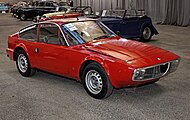| Alfa Romeo Giulia (Type 105) | |
|---|---|
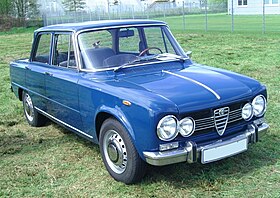 Alfa Romeo Giulia Super Alfa Romeo Giulia Super | |
| Overview | |
| Manufacturer | Alfa Romeo |
| Production | 1962–1978 |
| Assembly | Portello Plant, Milan, Italy (1962–1965) Arese Plant, Arese (MI), Italy (1965–1978) Setúbal, Portugal (Movauto) Willowvale (Salisbury), Zimbabwe (Willowvale Motor Industries) |
| Designer | Giuseppe Scarnati |
| Body and chassis | |
| Class | Large family car (D) |
| Body style | 4-door notchback saloon |
| Layout | Front-engine, rear-wheel-drive |
| Related | |
| Powertrain | |
| Engine | |
| Transmission | 4-speed manual (Giulia 1300) 5-speed manual |
| Dimensions | |
| Wheelbase | 2,510 mm (98.8 in) |
| Length | 4,140 mm (163.0 in) |
| Width | 1,560 mm (61.4 in) |
| Height | 1,430 mm (56.3 in) |
| Kerb weight | 978–1,130 kg (2,156–2,491 lb) |
| Chronology | |
| Predecessor | Alfa Romeo Giulietta (750/101) |
| Successor | Alfa Romeo Giulietta (116) |

Alfa Romeo Giulia (Italian pronunciation: [ˈdʒuːlja]) is the name of three not directly related models by the Italian car manufacturer Alfa Romeo. The first is a line of sporty four-door compact executive cars (Type 105) produced from 1962 to 1978, the second is an updated, mainly up-engined Spider, Sprint and Sprint Speciale Giuliettas, and the third Giulia is a compact executive car (type 952) unveiled in 2015.
Alfa Romeo was one of the first mainstream manufacturers to put a powerful engine in a light-weight 1 tonne (2,205 lb) four-door car for mass production. The Type 105 Giulia was equipped with a light alloy twin overhead camshaft four-cylinder engine similar to that of the earlier Giulietta (750/101) range, available in 1.3-litre (1,290 cc) and 1.6-litre (1,570 cc) versions. Various configurations of carburetors and tuning produced power outputs from about 80 to about 110 bhp (55 to 75 kW), coupled in most cases to 5-speed manual transmission.
Giulia sedans were noted for lively handling and impressive acceleration among small European four-door sedans of their era, especially considering modest engine sizes offered. The popular Super version with the twin carburettor 1.6 litre engine had a top speed of 170 km/h (106 mph) and accelerated from 0 to 100 km/h (62 mph) in about 12 seconds, better than many sports cars of the late 1960s and early 1970s. When leaving the factory all variations of the Giulia originally fitted either Pirelli Cinturato 165HR14 or 155HR15 tyres (CA67).
The styling of the boxy four-door notchback saloon was somewhat wanting. The engine bay, cabin and boot were all square shaped, buffered somewhat by details on the grill, roofline, bonnet and boot. Use of a wind tunnel during development led to a very aerodynamic shape that produced a drag coefficient of Cd=0.34, particularly low for a saloon of the era.
The Giulia Spider was succeeded by the Alfa Romeo Spider (105/115) in 1966.
Models

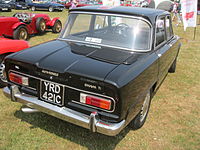 1965 Giulia TI; the C-shaped chrome trim around the tail lights is typical of the earliest Giulias.
1965 Giulia TI; the C-shaped chrome trim around the tail lights is typical of the earliest Giulias.
Note: chassis and engine type numbers displayed in italic for each model are sourced from Fusi 1978, pages 841–848.
Giulia TI
- Tipo: 105.14 (LHD, column shifter), 105.08 (LHD, floor shifter), 105.09 (RHD, floor shifter). Engine: 00514.
Unveiled on 27 June 1962 at the Autodromo Nazionale Monza, the Alfa Romeo Giulia TI was the very first of the Giulia family of cars to be introduced. Its 1,570 cc Alfa Romeo Twin Cam engine was fitted with a single Solex 33 PAIA 7 twin-choke down-draft carburettor, and produced 92 DIN-rated PS (68 kW; 91 hp) or 106 SAE-rated PS at 6,200 rpm. The "TI" nomenclature referred to a class of Italian saloon car racing known as "Turismo Internazionale", and had previously been applied to higher-performance versions of the 1900 and Giulietta saloons in the 1950s. However, for the Giulia saloon, the TI was at first the only version available, and later, with the introduction of the TI Super and Super, the TI became the base version in the 1.6-litre engine class. A distinguishing feature of the original Giulia were drum brakes on all corners, the front ones of the three-shoe type like on late Giuliettas; four-wheel Dunlop disc brakes and a brake servo were phased in during August 1963, after 22–23 thousand cars had been built. The car was marketed as a six-seater, thanks to a standard column-mounted shifter and a split bench front seat—though Italian car magazine Quattroruote found it rather a comfortable four-seater. Other notable interior features of the early models were mottled cloth and vinyl upholstery, a grey, trapezoid instrument panel including a strip speedometer, and a black steering wheel with two ivory-coloured spokes and a chrome half horn ring.
In May 1964 a floor shifter became available (chassis tipo 105.08), to be ordered solely in conjunction with the newly introduced separate front seats. Around the same time a right hand drive model variant entered production (tipo 105.09), with floor shifter only. In February 1966 several changes were made. The floor shifter became standard; the interior received new seats, a new dashboard with triple round instruments (two large ones and the smaller fuel gauge in the centre) in place of the strip speedometer, and new door cards. From outside these later TIs can be recognized by L-shaped chrome strips around the tail lights which supplanted the previous C-shaped ones. Production of the Giulia TI ceased during 1967; it was replaced by the Giulia 1600 S as the entry-level 1.6-litre model.
Giulia TI Super
- Tipo: 105.16. Engine: 00516.
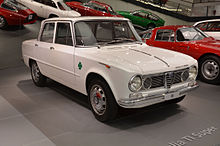
The Alfa Romeo Giulia TI Super was a special road-going sports model produced in limited numbers, fitted with a more powerful engine and a number of weight saving components, and intended for racing use. It was introduced to the press at the Monza race track on 24 April 1963. In total only 501 were made, 178 in 1963 and 323 1964. On 2 May 1964 the TI Super received international FIA and Italian CSAI homologation for racing, and was then extensively campaigned in the European Touring Car Challenge. Today the Giulia TI Super is rare and considered very desirable by collectors.
The TI Super's 1,570 cc engine was the same installed on the Giulia Sprint Speciale coupé—though bearing a different type code. It was fitted with two twin-choke horizontal Weber 45 DCOE 14 carburettors and, as on the Sprint Speciale, produced 112 DIN-rated PS (82 kW; 110 hp) or 129 SAE-rated PS at 6,500 rpm, pushing top speed to over 185 km/h (115 mph). Dry weight was 910 kilograms (2,006 lb) compared to 1,000 kg (2,205 lb) of the standard Giulia TI. Parts contributing to the weight reduction were mesh grilles replacing the inner pair of head lamps, bumpers without overriders, fixed front quarter windows, Plexiglas rear windows, and magnesium alloy wheels with hubcaps, very similar in appearance to the standard steel wheels of the TI. Braking was by discs all around, although the first cars used drums. Cars built from August 1964 used the bodyshell of the TI with mounting points for the brake servo, but were never fitted with one. On the inside both the gear shifter and the handbrake lever were moved to the floor. The TI's instrument cluster with its strip speedometer was replaced by a three-instrument binnacle comprising speedometer, tachometer and a multi-gauge instrument (fuel level, water temperature, oil temperature and oil pressure). The steering wheel was a three-spoke aluminium lightweight item with centre horn button. Front racing-type bucket seats and safety belts were standard, while the heater, door armrests, the grab handle in front of the passenger, the glove box lid, and ashtrays were deleted. Visually the Giulia TI Super was made immediately recognizable by green quadrifoglios (four-leaf clovers) on the front wings and tail panel, and "Giulia TI Super" scripts on the engine bonnet and tail. All cars produced were painted white, save for two examples—one red and one grey.
Contrary to popular belief, the Giulias used by the Italian police forces (the Pantere of the Polizia di Stato and Gazzelle of the Carabinieri) were not tuned TI Supers but rather standard models; early ones were fitted with mesh in place of the inner headlights like the TI Super simply to make the siren mounted behind sound louder. Only two TI Supers were actually owned by the Polizia, and used at the police schools of Nettuno and Cesena.
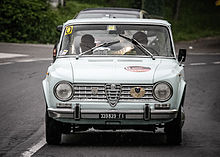
Giulia 1300
- Tipo: 105.06. Engine: 00506.
The Giulia 1300 marked the Giulia's entry in the then crowded 1.3-litre class, and featured simplified trim and equipment. It was introduced on 11 May 1964 at the Autodromo Nazionale Monza and produced until 1971, in left hand drive only. At first the Giulia 1300 was sold alongside the slightly cheaper Giulietta TI, the last of the outgoing 101-series Giulietta saloons, in its last year of production. In fact the Giulia used a twin cam engine derived from the Giulietta TI's. Equipped with a single Solex 32 PAIA 7 down-draft twin-choke carburettor, this updated 1,290 cc four-cylinder produced 78 DIN-rated PS (57 kW; 77 hp) or 89 SAE-rated PS at 6,000 rpm. Top speed was 155 km/h (96 mph). A four-speed gearbox with floor change fitted as standard; the 1300 would remain the only Giulia model not fitted with a five-speed gearbox. Braking was by discs all around, without a servo at first, later with a servo.
Visually the 1300 was distinguished by a new grille design housing single instead of twin head lamps, rectangular side repeaters without ornamentation, and all-metal hubcaps. It also did without bumper over-riders, most pieces of exterior chrome trim, and rear back-up lamps. Inside dashboard and steering wheel came from the TI (though the latter was all-black), there were rubber mats instead of carpets, and several convenience features such as the passenger grab handle and rear ashtrays were omitted. In September 1967 the Giulia 1300 was updated, adopting a black mesh grille with three horizontal chrome bars, the vertical louvres at the base of the windshield first seen on the Giulia Super, the second series Giulia TI three round instrument dashboard, and the 1300 ti's three-spoke steering wheel.
Giulia Super
Tipo 105.26 was introduced at the 1965 Geneva Motor Show. It transferred the technology from the racing TI Super to a road car, to make the most successful Giulia saloon. 1,570 cc engine with two double-choke Weber 40DCOE carburettors for a milder, but torquier tune than the TI Super - 98 PS (72 kW; 97 hp) at 5500 rpm. New dashboard with two large round instruments (speedo and tacho) and clock. Sportier steering wheel with three aluminium spokes and centre horn push, similar to that of the Ti Super, later changed for one with the horn pushes in the spokes. All-around disc brakes with servo were fitted as standard from the outset. The serpent crest of the Sforza family appears in a badge on the C-pillar and is a distinguishing feature of the Super saloon. For 1968, there was a suspension update, including revised geometry and a rear anti-roll bar. The wheels were changed in size from 5J x 15 to 5J x 14, and tires from 155/15 Pirelli Cinturato to 165/14 Pirelli Cinturato. For 1970, updates included dual-circuit brakes, centre-mounted handbrake lever to replace under-dash "umbrella handle", larger external door handles, and top-hinged pedals (the latter in left hand drive models only; right hand drive continued with bottom-hinged pedals to the end of production). In 1972, Tipo 105.26 was rationalised into the Giulia 1.3 - Giulia 1.6 range (see below).
| Version | Years of production |
|---|---|
| Giulia 1600 TI | From 1962 to 1967 |
| Giulia 1600 TI Super | From 1963 to 1964 |
| Giulia 1300 | From 1964 to 1971 |
| Giulia Super | From 1965 to 1972 |
| Giulia 1300 ti | From 1966 to 1972 |
| Giulia 1300 Super | From 1970 to 1972 |
| Giulia 1600 S | From 1968 to 1970 |
| Giulia Super 1.3 | From 1972 to 1974 |
| Giulia Super 1.6 | From 1972 to 1974 |
| Giulia Nuova Super 1.3 | From 1974 to 1977 |
| Giulia Nuova Super 1.6 | From 1974 to 1977 |
| Giulia Nuova Super Diesel | From 1976 to 1977 |
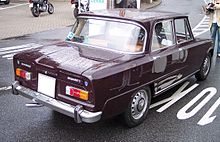
Giulia 1300 ti
Tipo 105.39 was built from 1965 to 1972. Right hand drive model replaced in 1970 by the 1300 Super (see below). It mounted a 1,290 cc engine with single down-draft carburettor for 82 PS (60 kW; 81 hp) at 6000 rpm. Unlike the re-deployed 101-series Giulietta engine of the austerity-model 1300, the 1300 ti motor was a 105 series engine, basically that of the sportier GT1300 Junior coupe with different camshaft timing (but the same camshafts) and induction system. Other features were the five-speed gearbox, a three-spoke bakelite steering wheel with plastic horn push covering the centre and spokes, and the dashboard initially with strip speedo like that of the TI. For 1968, updates included a dashboard based on that of the Super, but with a simpler instrument binnacle, still featuring two large round instruments (speedo and tacho) and a separate fuel gauge, and the same suspension, wheel and tire updates applied to the Giulia Super in the same year. 1970 updates included dual-circuit brakes, centre handbrake, larger external doorhandles and top-hinged pedals (on left hand drive cars only), again as applied to the Super for that year.
Giulia 1600 S
Tipo 105.85 was basically a Giulia TI re-introduced in 1968 as a lower-level model to come between the 1300 and 1300 ti on one hand, and the Super on the other. It had a re-interpretation of the 1,570 cc single-carburettor engine for 95 PS (70 kW; 94 hp) at 5500 rpm and similar trim to the 1300 ti. Replaced in 1970 by the 1300 Super (see below) which offered similar performance in a lower tax bracket. The last cars from 1970 featured the top-hinged pedals, centre handbrake and dual-circuit brakes as for the Super and 1300 ti.

Giulia 1300 Super
Tipo 115.09 was introduced in 1970. It was basically a 1300 ti fitted with the engine from the GT 1300 Junior coupe that featured two double-choke horizontal carburettors; the engine actually had the GT 1300 Junior type number. This model was rationalised into the Giulia Super 1.3 - Giulia Super 1.6 range in 1972.
Giulia Super 1.3 and Giulia Super 1.6
In 1972 a rationalisation of the Giulia range saw the Super 1300 (Tipo 115.09) and the Super (Tipo 105.26) re-released as the Super 1.3 and Super 1.6. The two models featured the same equipment, interior and exterior trim, differing only in engine size (1,290 cc and 1,570 cc) and final drive ratio. The 1300 ti was dropped. A small Alfa Romeo badge on the C-pillar is a distinguishing feature, as are hubcaps with exposed wheel nuts.
1600 Rallye
In December 1972, Alfa-Romeo South Africa released the 1600 Rallye. This locally developed more powerful 1600 cc version of the 1300 Super, using the 1300s single-headlight body shell. The car was largely ready for competition and was only planned to be built in limited numbers, and was fitted with racing-style rear-view mirrors, rally lamps, fully adjustable seats, and a limited-slip differential. Claimed power was 125 hp (93 kW; 127 PS) SAE.
Giulia Nuova Super

The Giulia Super range was re-released in 1974 as the Nuova Super range, including the Giulia Nuova Super 1300 and 1600 This and featured a new black plastic front grille and a flat boot (trunk) lid without the characteristic centre spine. Otherwise the cars differed little from their Giulia Super predecessors and bore the same Tipo numbers with an S suffix. Production ceased in 1977.
Giulia Nuova Super Diesel
- Tipo: 115.40. Engine: 108U.
Introduced in June 1976, the Giulia Nuova Super Diesel became the first ever diesel engined Alfa Romeo passenger car. It was fitted with a naturally aspirated Perkins type 4.108 1,760 cc four cylinder, the same engine used on the Alfa Romeo F12 van. With an output of 55 SAE-rated PS (40 kW; 54 hp) at 4,000 rpm and a 138 km/h (86 mph) top speed, the diesel version was the slowest of all Giulias. In total 6,537 examples were made up to 1977. The diesels were not quite in line with Alfa Romeo's sporting image, but Alfa's president stated that Italy's fiscal legislation so favoured diesels that the company was simply forced to offer such an option.
Engines and performance
Unless noted otherwise, DIN rated horsepower and torque is given.
| Model | Years | Engine | Compr. ratio |
Fuel system | Power | Torque | Top speed |
|---|---|---|---|---|---|---|---|
| Giulia 1300 | 1964–71 | 1,290 cc Twin Cam | 8.5:1 | 1x twin carb. | 78 PS (57 kW; 77 hp) at 6,000 rpm | 102 N⋅m (75 lb⋅ft) at 4,700 rpm | 155 km/h (96 mph) |
| Giulia 1300 ti | 1966–72 | 9.0:1 | 1x twin carb. | 82 PS (60 kW; 81 hp) at 6,000 rpm | 104 N⋅m (77 lb⋅ft) at 4,900 rpm | 160 km/h (99 mph) | |
| Giulia 1300 Super | 1970–72 | 9.0:1 | 2x twin carbs. | 89 PS (65 kW; 88 hp) at 6,000 rpm | 140 N⋅m* (103 lb⋅ft) at 3,200 rpm | 165 km/h (103 mph) | |
| Giulia Super 1.3 | 1972–74 | ||||||
| Giulia Nuova Super 1300 | 1974–77 | ||||||
| Giulia TI | 1962–67 | 1,570 cc Twin Cam | 9.0:1 | 1x twin carb. | 92 PS (68 kW; 91 hp) at 6,200 rpm | 130 N⋅m (96 lb⋅ft) at 4,000 rpm | 165 km/h (103 mph) |
| Giulia TI Super | 1963–64 | 9.7:1 | 2x twin carbs. | 112 PS (82 kW; 110 hp) at 6,500 rpm | n/a | 185 km/h (115 mph) | |
| Giulia 1600 S | 1969–70 | 9.0:1 | 1x twin carb. | 95 PS (70 kW; 94 hp) at 5,500 rpm | n/a | 170 km/h (106 mph) | |
| Giulia Super | 1965–69 | 9.0:1 | 2x twin carbs. | 98 PS (72 kW; 97 hp) at 5,500 rpm | 136 N⋅m (100 lb⋅ft) at 3,000 rpm | 175 km/h (109 mph) | |
| 1969–72 | 9.0:1 | 2x twin carbs. | 102 PS (75 kW; 101 hp) at 5,500 rpm | 162 N⋅m* (119 lb⋅ft) at 2,900 rpm | 175 km/h (109 mph) | ||
| Giulia Super 1.6 | 1972–74 | ||||||
| Giulia Nuova Super 1600 | 1974–77 | ||||||
| Giulia Nuova Super Diesel | 1976–77 | 1,760 cc Perkins 4.108 diesel | 22:1 | Injection pump | 55 PS* (40 kW; 54 hp) at 4,000 rpm | 101 N·m* (74 lb⋅ft) at 2,200 rpm | 138 km/h (86 mph) |
- Notes
- * SAE rated
Giulia Spider, Sprint and Sprint Speciale
Further information: Alfa Romeo Giulia Sprint SpecialeThe Spider, Sprint and Sprint Speciale Giulias introduced together with the Giulia sedan in 1962 were rebadged and updated versions of earlier Giulietta models (series 101), now with a 92 CV (68 kW; 91 hp) 1.6 litre instead of a 1.3 litre engine. Easiest to distinguish from a Giulietta is the Spider (tipo 101.23), which featured a bonnet bulge to clear the slightly taller engine. The Giulia Sprint 1600 (tipo 101.12) arrived in June 1962. The Sprint coupé was also available for a short time with the 1.3 litre engine as the Sprint 1300 - essentially a Giulietta Sprint with a different name. This version carries a small "1300" script on the lower bootlid, while Giulia 1600 Sprints have a "1600" badge just behind the rear wheel. Most models were discontinued in 1964, although the Sprint Speciale continued until 1966. The Spider was complemented by a Spider Veloce in 1964 (tipo 101.18), using the engine seen in the Giulia Sprint Speciale and Giulia TI Super, producing 112 CV (82 kW; 110 hp). The Giulia Spider continued to be available until the mid-1966 introduction of the Spider 1600 Duetto.
Giulia Sprint GT
Main article: Alfa Romeo 105/115 Series CoupésIn 1963 the Alfa Romeo Giulia Sprint GT (tipo 105) was first shown. This coupé (and rare convertible sister, the Giulia GTC) proceeded to be developed through numerous series with engines from 1.3 up to 2 liters. Production ended in 1976. There was also a range of competition models called the GTA as well as a Zagato-bodied iteration called the Junior Z.
2015 Alfa Romeo Giulia (952)

The Giulia (952) compact executive car was unveiled on 24 June 2015 at the Museo Storico Alfa Romeo in Arese. The all-new model is the first product of the company's revival plan, which will see the brand return to a rear wheel drive platform with the option of all wheel drive. The new model was shown in the high-performance "Quadrifoglio" specification.
Following the success of the Giulia, Alfa Romeo unveiled the Stelvio - Alfa Romeo's first ever SUV - at the 2016 Los Angeles Auto Show. Production started at the Cassino Plant end of 2016, attaining top-Alfa sales by 2018.
The Giulia Quadrifoglio has been highly praised by the motoring press when compared against its nearest rivals, including the highly specified later generations of BMW M3, it has gone on to be voted "Best Super Saloon" 4 years running deposing BMW of the prime position between 2016 and 2020 (UK - Autocar Magazine)
See also
- Alfa Romeo Sprint GT (Veloce)
- Alfa Romeo Spider
- Alfa Romeo Giulia TZ
- Alfa Romeo Giulia Sprint Speciale
- Alfa Romeo GTA
- Alfa Romeo Montreal
Notes
- Google-books: Alfa Romeo Berlinas - John Tipler - Google-kirjat, accessdate: 21. October 2018
- "1964 Alfa Romeo Giulia Super". histomobile.com. Archived from the original on 2008-07-24. Retrieved 2008-09-05.
- ^ "1964 Alfa Romeo Giulia 1300". carfolio.com. Archived from the original on 27 September 2007. Retrieved 2007-09-05.
- "Alfa Romeo Giulia". carsfromitaly.net. Archived from the original on 27 September 2007. Retrieved 2007-09-05.
- ^ Classic Driver Market: . This punchy power plant ensured the cars performance was better than many sports car of the era. Alf, accessdate: 31. July 2017
- "L'Alfa Romeo Giulia festeggia 50 anni". Il Sole 24 ore. 27 June 2012. Retrieved 9 July 2012.
- "La nuova Alfa Romeo "Giulia", ultima di una serie". Panorama. 25 June 2012. Retrieved 10 July 2012.
- Hemmings Motor News: https://www.hemmings.com/magazine/hsx/2017/04/Aerodynamic-Efficiency---1969-Alfa-Romeo-Giulia-1300-TI/3750710.html, accessdate: 30. July 2017
- ^ Fusi 1978, p. 569–578.
- ^ "Alfa Romeo "Giulia T.I."". Quattroruote (road test) (80). Editoriale Domus: 72–83. August 1962.
- ^ Deganello, Elvio (November 2004). "Dossier: Alfa Romeo Giulia—Disegnata dal vento" [Dossier: Alfa Romeo Giulia—Designed by the wind]. Automobilismo d'Epoca (in Italian) (V). Edisport editoriale S.p.A.: 84–111.
- ^ Fusi 1978, p. 585–586.
- Fusi 1978, p. 862–867.
- "1965 Alfa Romeo Giulia TI". sportscarmarket.com. Archived from the original on 9 September 2007. Retrieved 2007-09-04.
- Alfa Romeo Giulia TI Super—Uso e manutenzione (owner's manual). Alfa Romeo S.p.A.
- ^ "Alfa Romeo Giulia Dossier". Auto Italia (235). Letchworth, Hertfordshire: Ginger Beer Promotions Ltd: 46–54. September 2015.
- ^ Fusi 1978, p. 601–603.
- ^ "Alfa Romeo "Giulia 1300"". Quattroruote (road test) (104). Editoriale Domus. August 1964.
- ^ Wright, Cedric, ed. (December 1972). "Alfa-Romeo 1600 Rallye and 1600 GT Coupe". CAR (South Africa). Vol. 16, no. 11. Cape Town, South Africa: Ramsay, Son & Parker (Pty) Ltd. p. 17.
- ^ Fusi 1978, p. 775–776.
- ^ C., F. (30 June 1976). "La Giulia per prima si converte al diesel" [For the first time, the Giulia is converted to a diesel]. Stampa Sera (in Italian). Archived from the original on 2017-03-16.
- Seidler, Edouard (1982-06-05). "Alfa's Rising Sun". Autocar. Vol. 156, no. 4459. IPC Business Press Ltd. p. 20.
- Fusi (1978).
- "Alfa Romeo "Giulia 1300 ti"". Quattroruote (road test) (123). Editoriale Domus: 100–109. March 1966.
- "Alfa Romeo "Giulia 1300 Super"". Quattroruote (road test) (181). Editoriale Domus: 84–93. January 1971.
- "Alfa Romeo Giulia Super". Motor (road test). 9 July 1966.
- "Alfa Romeo "Giulia Super 1.6"". Quattroruote (road test) (198). Editoriale Domus: 108–119. June 1972.
- "The Alfa Romeo Giulia is a 503bhp, RWD super-saloon". Top Gear. 2015-06-24. Retrieved 2016-07-04.
References
- Fusi, Luigi (1978). Alfa Romeo—Tutte le vetture dal 1910—All cars from 1910 (3rd ed.). Milan: Emmeti Grafica editrice.
External links
- Motorbase: Alfa Romeo Giulia Ti/Super Archived 2006-11-16 at the Wayback Machine (1962–1972)
- Motorbase: Alfa Romeo Giulia Sprint GT/Sprint GT Veloce/GTC Archived 2007-01-20 at the Wayback Machine (1963–1968)
- Motorbase: Alfa Romeo Giulia 1300/1300TI/1300 Super Archived 2006-11-16 at the Wayback Machine (1964–1972)
- All models and series, provided with images and descriptions
- Alfa Romeo Giulia at the Internet Movie Cars Database
- allcarsmanuals.com: Workshop manuals and technical information
| « previous — Alfa Romeo vehicle timeline, 1950s–1970s — next » | ||||||||||||||||||||||||||||||||||||||||||||||||||||||||||||||||||||||||||||||||||||||||||||||||||||||||||||||||||||||||||||||||||||||||||||||||||||||||||||||||||||||||||||||||||||||||||||||||||||||||||||||||||||||||||||||||||||||||||||||||||||||||||||||||||||||||||||||||||||||||||||||||||||||||||||||||||||||||||||||||||||||||||||||||||||||||||||||||||||||||||||||||||||||||||||||||||||||||||||||||||||||||||||||||||||||||||||||||||||||||||||||||||||||||||||||||||||||||||||||||||||||||||||||||||||||||||||||||||||||||||||||||||||||||||||||||||||||||||||||||||||||||||||||||||||||||||||||||||||||||||||||||||||||||||||||||||||||||||||||||||||||||||||||||||||||||||||||||||||||||||||||||||||||||||||||||
|---|---|---|---|---|---|---|---|---|---|---|---|---|---|---|---|---|---|---|---|---|---|---|---|---|---|---|---|---|---|---|---|---|---|---|---|---|---|---|---|---|---|---|---|---|---|---|---|---|---|---|---|---|---|---|---|---|---|---|---|---|---|---|---|---|---|---|---|---|---|---|---|---|---|---|---|---|---|---|---|---|---|---|---|---|---|---|---|---|---|---|---|---|---|---|---|---|---|---|---|---|---|---|---|---|---|---|---|---|---|---|---|---|---|---|---|---|---|---|---|---|---|---|---|---|---|---|---|---|---|---|---|---|---|---|---|---|---|---|---|---|---|---|---|---|---|---|---|---|---|---|---|---|---|---|---|---|---|---|---|---|---|---|---|---|---|---|---|---|---|---|---|---|---|---|---|---|---|---|---|---|---|---|---|---|---|---|---|---|---|---|---|---|---|---|---|---|---|---|---|---|---|---|---|---|---|---|---|---|---|---|---|---|---|---|---|---|---|---|---|---|---|---|---|---|---|---|---|---|---|---|---|---|---|---|---|---|---|---|---|---|---|---|---|---|---|---|---|---|---|---|---|---|---|---|---|---|---|---|---|---|---|---|---|---|---|---|---|---|---|---|---|---|---|---|---|---|---|---|---|---|---|---|---|---|---|---|---|---|---|---|---|---|---|---|---|---|---|---|---|---|---|---|---|---|---|---|---|---|---|---|---|---|---|---|---|---|---|---|---|---|---|---|---|---|---|---|---|---|---|---|---|---|---|---|---|---|---|---|---|---|---|---|---|---|---|---|---|---|---|---|---|---|---|---|---|---|---|---|---|---|---|---|---|---|---|---|---|---|---|---|---|---|---|---|---|---|---|---|---|---|---|---|---|---|---|---|---|---|---|---|---|---|---|---|---|---|---|---|---|---|---|---|---|---|---|---|---|---|---|---|---|---|---|---|---|---|---|---|---|---|---|---|---|---|---|---|---|---|---|---|---|---|---|---|---|---|---|---|---|---|---|---|---|---|---|---|---|---|---|---|---|---|---|---|---|---|---|---|---|---|---|---|---|---|---|---|---|---|---|---|---|---|---|---|---|---|---|---|---|---|---|---|---|---|---|---|---|---|---|---|---|---|---|---|---|---|---|---|---|---|---|---|---|---|---|---|---|---|---|---|---|---|---|---|---|---|---|---|---|---|---|---|---|---|---|---|---|---|---|---|---|---|---|---|---|---|---|---|---|---|---|---|---|---|---|---|---|---|---|---|---|---|---|---|---|---|---|---|---|---|---|---|---|---|---|---|---|---|---|---|---|---|---|---|---|---|---|---|---|---|---|---|---|---|---|---|---|---|---|---|---|---|---|---|---|---|---|---|---|---|---|---|---|---|---|---|---|---|---|---|---|---|---|---|---|---|---|---|---|---|---|---|---|---|---|---|---|---|---|---|---|---|---|---|---|---|---|---|---|---|---|---|---|---|---|---|---|---|---|---|---|---|---|---|---|---|---|---|---|---|---|---|---|---|---|---|---|---|---|---|---|---|---|---|---|---|---|---|---|---|---|---|---|---|---|---|---|---|---|---|---|---|---|---|---|---|---|---|---|---|---|---|---|---|
| ||||||||||||||||||||||||||||||||||||||||||||||||||||||||||||||||||||||||||||||||||||||||||||||||||||||||||||||||||||||||||||||||||||||||||||||||||||||||||||||||||||||||||||||||||||||||||||||||||||||||||||||||||||||||||||||||||||||||||||||||||||||||||||||||||||||||||||||||||||||||||||||||||||||||||||||||||||||||||||||||||||||||||||||||||||||||||||||||||||||||||||||||||||||||||||||||||||||||||||||||||||||||||||||||||||||||||||||||||||||||||||||||||||||||||||||||||||||||||||||||||||||||||||||||||||||||||||||||||||||||||||||||||||||||||||||||||||||||||||||||||||||||||||||||||||||||||||||||||||||||||||||||||||||||||||||||||||||||||||||||||||||||||||||||||||||||||||||||||||||||||||||||||||||||||||||||






